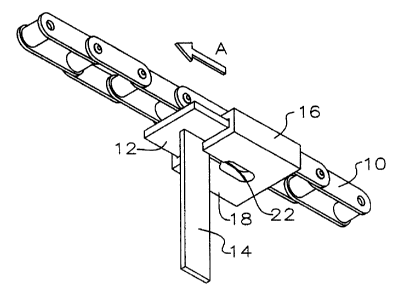Some of the information on this Web page has been provided by external sources. The Government of Canada is not responsible for the accuracy, reliability or currency of the information supplied by external sources. Users wishing to rely upon this information should consult directly with the source of the information. Content provided by external sources is not subject to official languages, privacy and accessibility requirements.
Any discrepancies in the text and image of the Claims and Abstract are due to differing posting times. Text of the Claims and Abstract are posted:
| (12) Patent: | (11) CA 2483808 |
|---|---|
| (54) English Title: | SLIDER BLOCK FOR PUSHER LUG |
| (54) French Title: | COULISSEAU POUR PLATEAU-POUSSOIR |
| Status: | Deemed expired |
| (51) International Patent Classification (IPC): |
|
|---|---|
| (72) Inventors : |
|
| (73) Owners : |
|
| (71) Applicants : |
|
| (74) Agent: | BORDEN LADNER GERVAIS LLP |
| (74) Associate agent: | |
| (45) Issued: | 2007-12-04 |
| (22) Filed Date: | 2004-10-04 |
| (41) Open to Public Inspection: | 2005-07-08 |
| Examination requested: | 2005-12-07 |
| Availability of licence: | N/A |
| (25) Language of filing: | English |
| Patent Cooperation Treaty (PCT): | No |
|---|
| (30) Application Priority Data: | ||||||
|---|---|---|---|---|---|---|
|
An improved slider block is a length of flanged channel having a cut-out in the lower web of the channel to accommodate mounting a flat bar journalled in the cut-out. The flanged channel is resilient. The flanged channel has a length sufficient to cover the length of a base plate on which the flat bar is orthogonally mounted. The sides of the channel define a cavity having a depth corresponding to the thickness of the base plate. A pair of flanges extend inwardly over the cavity from the sides of the channel so as to define a chain-receiving slot therebetween. The base plate mounts within the cavity. The base plate is welded to a chain so that when the base plate is mounted in the cavity the chain is mounted in and along the chain-receiving slot.
Un bloc coulissant amélioré est une longueur de canal à bride présentant une découpe dans la bande inférieure du canal pour recevoir le montage d'une barre plate tourillonnée dans la découpe. Le canal à bride est élastique. Le canal à bride a une longueur suffisante pour couvrir la longueur d'une plaque de base sur laquelle la barre plate est montée orthogonalement. Les côtés du canal définissent une cavité ayant une profondeur correspondant à l'épaisseur de la plaque de base. Une paire de brides s'étendent vers l'intérieur au-dessus de la cavité à partir des côtés du canal de manière à définir une fente de réception de chaîne entre eux. La plaque de base est montée à l'intérieur de la cavité. La plaque de base est soudée à une chaîne de telle sorte que lorsque la plaque de base est montée dans la cavité dans laquelle la chaîne est montée et le long de la fente de réception de chaîne.
Note: Claims are shown in the official language in which they were submitted.
Note: Descriptions are shown in the official language in which they were submitted.

For a clearer understanding of the status of the application/patent presented on this page, the site Disclaimer , as well as the definitions for Patent , Administrative Status , Maintenance Fee and Payment History should be consulted.
| Title | Date |
|---|---|
| Forecasted Issue Date | 2007-12-04 |
| (22) Filed | 2004-10-04 |
| (41) Open to Public Inspection | 2005-07-08 |
| Examination Requested | 2005-12-07 |
| (45) Issued | 2007-12-04 |
| Deemed Expired | 2022-10-04 |
There is no abandonment history.
Note: Records showing the ownership history in alphabetical order.
| Current Owners on Record |
|---|
| USNR KOCKUMS CANCAR HOLDINGS ULC |
| Past Owners on Record |
|---|
| COE NEWNES/MCGEHEE INC. |
| COE NEWNES/MCGEHEE ULC |
| HALVERSON, BRUCE G. |
| HENDERSON, DEANE |
| USNR/KOCKUMS CANCAR COMPANY |
| WIGHT, GEOFF |
| WILLEY, JASON |